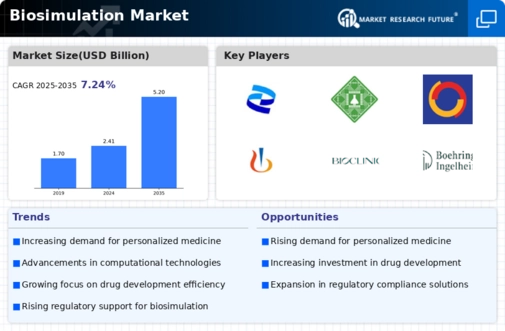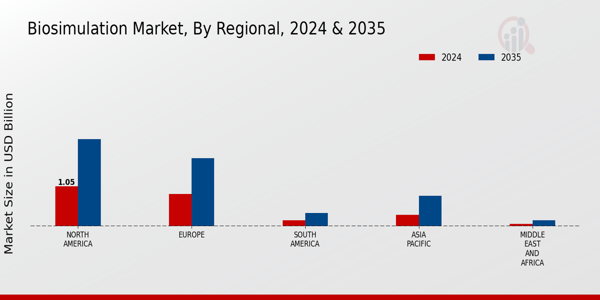Market Growth Projections
The Global Biosimulation Market Industry is poised for substantial growth, with projections indicating an increase from 2.41 USD Billion in 2024 to 5.2 USD Billion by 2035. This trajectory suggests a robust compound annual growth rate of 7.24% from 2025 to 2035. Such growth can be attributed to various factors, including technological advancements, regulatory support, and the rising demand for personalized medicine. As the industry evolves, it is essential to monitor these trends and their implications for stakeholders across the biosimulation landscape.
Rising Demand for Drug Development
The Global Biosimulation Market Industry experiences a notable surge in demand driven by the increasing need for efficient drug development processes. As pharmaceutical companies seek to reduce the time and cost associated with bringing new drugs to market, biosimulation technologies offer a viable solution. In 2024, the market is projected to reach 2.41 USD Billion, reflecting the industry's shift towards more predictive modeling approaches. This trend is likely to continue as companies aim to streamline clinical trials and enhance drug efficacy, ultimately contributing to the projected market growth to 5.2 USD Billion by 2035.
Regulatory Support for Biosimulation
Regulatory bodies increasingly recognize the value of biosimulation in drug development, which serves as a key driver for the Global Biosimulation Market Industry. Agencies such as the FDA and EMA have begun to incorporate biosimulation data into their approval processes, thereby legitimizing its use in regulatory submissions. This support not only encourages pharmaceutical companies to adopt biosimulation practices but also fosters innovation within the industry. As regulatory frameworks evolve to embrace these technologies, the market is likely to witness accelerated growth, further solidifying biosimulation's role in modern drug development.
Growing Focus on Personalized Medicine
The shift towards personalized medicine significantly influences the Global Biosimulation Market Industry. As healthcare moves away from one-size-fits-all approaches, biosimulation allows for the modeling of individual patient responses to therapies. This capability is crucial for optimizing treatment plans and improving patient outcomes. The increasing prevalence of chronic diseases necessitates tailored therapeutic strategies, thereby driving demand for biosimulation tools. With the market projected to grow from 2.41 USD Billion in 2024 to 5.2 USD Billion by 2035, the emphasis on personalized medicine is expected to be a major catalyst for this expansion.
Emerging Markets and Global Collaboration
Emerging markets present a wealth of opportunities for the Global Biosimulation Market Industry. As countries invest in healthcare infrastructure and research capabilities, the demand for biosimulation technologies is likely to rise. Collaborative efforts between global pharmaceutical companies and local research institutions can enhance the development and application of biosimulation tools in these regions. This trend not only fosters innovation but also facilitates knowledge transfer, ultimately contributing to the market's growth. The anticipated compound annual growth rate of 7.24% from 2025 to 2035 suggests that global collaboration will play a crucial role in shaping the future landscape of biosimulation.
Advancements in Computational Technologies
Technological advancements in computational methods play a pivotal role in propelling the Global Biosimulation Market Industry forward. The integration of artificial intelligence and machine learning into biosimulation tools enhances predictive accuracy and efficiency. These innovations allow researchers to simulate complex biological systems with greater precision, thereby facilitating the development of personalized medicine. As computational power continues to increase, the market is expected to expand significantly, with a compound annual growth rate of 7.24% anticipated from 2025 to 2035. This growth underscores the importance of cutting-edge technology in shaping the future of drug discovery.
























